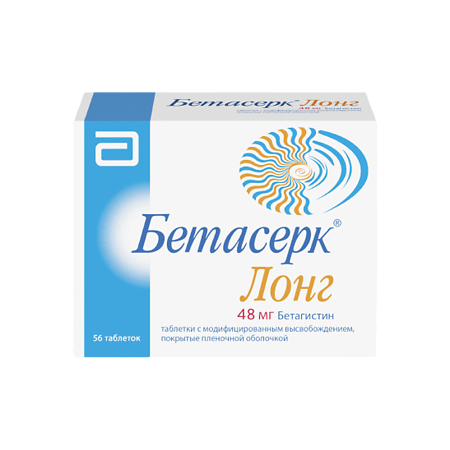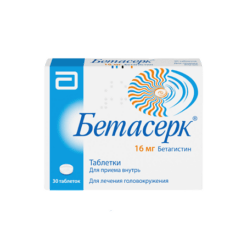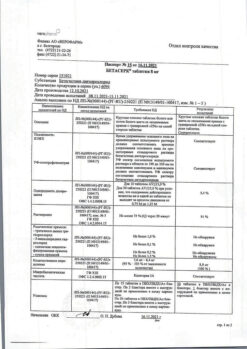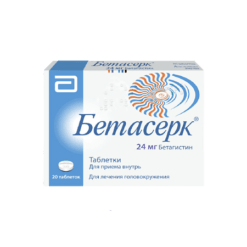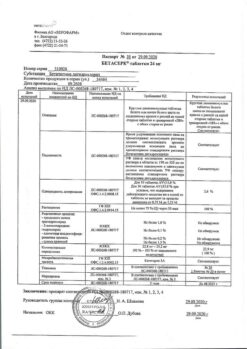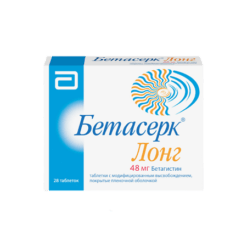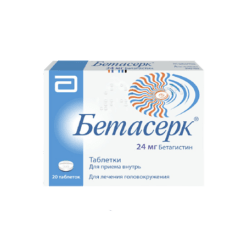No products in the cart.
Betaserk Long, 48 mg 56 pcs.
€58.68 €48.90
Description
Pharmacotherapeutic group: histamine drug
ATC code: N07CA01
Pharmacological properties
.Pharmacodynamics
The mechanism of action of betahistine is only partially known. There are several possible hypotheses supported by preclinical and clinical data:
- Influence on the histaminergic system
Partial agonist of H1-histamine and antagonist of H3-histamine receptors of the CNS vestibular nuclei, with little activity against
H2-receptors. Betahistine increases histamine metabolism and release by blocking presynaptic H3 receptors and decreasing H3 receptors.
- Augment blood flow to the cochlear region as well as the entire brain
According to preclinical studies, betahistine improves blood flow in the inner ear vasculature by relaxing the precapillary sphincters of the inner ear vessels. Betahistine has also been shown to increase cerebral blood flow in humans.
- Easing central vestibular compensation
Betahistine accelerates vestibular function recovery in animals after unilateral vestibular neurectomy by accelerating and facilitating central vestibular compensation through antagonism with H3-histamine receptors.
The recovery time after vestibular neurectomy in humans is also reduced with treatment with betahistine.
- Inhibits neuronal excitation in the vestibular nuclei
Dose-dependently reduces the generation of action potentials in the neurons of the lateral and medial vestibular nuclei.
Pharmacodynamic properties found in animals provide a positive therapeutic effect of betahistine in the vestibular system.
The efficacy of betahistine has been demonstrated in patients with vestibular vertigo and Meniere’s syndrome, as evidenced by a reduction in the severity and frequency of dizziness.
Pharmacokinetics
absorption
. When taken orally, betahistine is rapidly and almost completely absorbed in the gastrointestinal tract. After absorption, the drug is rapidly and almost completely metabolized to form the inactive metabolite 2-pyridylacetic acid. The plasma concentration of betahistine is very low. Thus, pharmacokinetic assays are based on measuring the concentration of the metabolite
2-pyridylacetic acid (2-PAA) in plasma and urine.
For Betaserc® Long, the maximum concentration (Cmax) averages (±SD) 847±147 ng/mL, time to maximum concentration (Tmax) is 0.333-2.0 h (median 1.0 h), time to latency Tlag is 0 h. The terminal elimination half-life (T1/2) is 5.54±1.57 h, the terminal elimination constant (λz) is 0.134±0.036 h-1. The total plasma exposure of 2-PAA is: AUC0-inf – 7266±1338 h×ng/mL (geometric mean 7141 h×ng/mL), AUC0-t – 7159±1327 h×ng/mL (geometric mean 7035 h×ng/mL), AUC0-24, corresponding to an AUC0-t, of 6621±111111 h×ng/mL (geometric mean 6524 h×ng/mL).
A single administration of Betaserc® Long Cmax 2-RAA increased 1.2-fold compared with consecutive administration of two Betaserc® 24 mg tablets at
12-hour intervals. Tmax when taking Betaserc® Long is increased by an average of 0.33 h. The elimination half-life of 2-PAAs while taking Betaserc® Long increased by an average of 1.4 times. Total exposure when taking 1 tablet of Betaserc® Long averaged 0.91 of the AUC0-24, 0.83 of the AUC0-t and 0.84 of the AUC0-inf when taking 2 tablets of Betaserc® 24 mg.
The administration of a single dose of Betaserc® Long achieves plasma 2-PAA exposure comparable to twice-daily administration of Betaserc® 24 mg, but without significantly increasing maximum plasma concentrations.
Eating has no effect on the pharmacokinetics of 2-PAA when taking Betaserc® Long.
Distribution
The binding of betahistine to plasma proteins is less than 5%.
Metabolism
After absorption, betahistine is rapidly and almost completely metabolized to form the metabolite 2-PAA (which has no pharmacological activity).
Elimation
2-PAA is rapidly excreted in the urine. When administered at a dose of 48 mg, about 85% of the initial dose is detected in the urine. Excretion of betahistine by the kidneys or through the intestine is insignificant.
Linearity
The excretion rate remains constant with oral administration of 48 mg of the drug, indicating linearity in the pharmacokinetics of betahistine, and suggesting that the metabolic pathway involved remains unsaturated.
Indications
Indications
Meniere’s syndrome, characterized by the following main symptoms:
dizziness (accompanied by nausea/vomiting)
hearing loss (hearing loss)
tinnitus
Symptomatic treatment of vestibular dizziness (vertigo).
Pharmacological effect
Pharmacological effect
Pharmacotherapeutic group: histamine preparation
ATX code: N07CA01
Pharmacological properties
Pharmacodynamics
The mechanism of action of betahistine is only partially known. There are several possible hypotheses supported by preclinical and clinical data:
Effect on the histaminergic system
Partial agonist of H1-histamine and antagonist of H3-histamine receptors of the vestibular nuclei of the central nervous system, has little activity against
H2 receptors. Betahistine increases histamine metabolism and release by blocking presynaptic H3 receptors and reducing the number of H3 receptors.
Increased blood flow to the cochlear region, as well as the entire brain
According to preclinical studies, betahistine improves blood circulation in the stria vascularis of the inner ear by relaxing the precapillary sphincters of the vessels of the inner ear. Betahistine has also been shown to increase cerebral blood flow in humans.
Facilitating the process of central vestibular compensation
Betahistine accelerates the recovery of vestibular function in animals after unilateral vestibular neurectomy by accelerating and facilitating central vestibular compensation through antagonism of histamine H3 receptors.
Recovery time after vestibular neurectomy in humans is also reduced when treated with betahistine.
Suppression of neuronal excitation in the vestibular nuclei
Dose-dependently reduces the generation of action potentials in neurons of the lateral and medial vestibular nuclei.
Pharmacodynamic properties identified in animals provide a positive therapeutic effect of betahistine in the vestibular system.
The effectiveness of betahistine has been demonstrated in patients with vestibular vertigo and Meniere’s syndrome, which was manifested by a decrease in the severity and frequency of dizziness.
Pharmacokinetics
Suction
When taken orally, betahistine is quickly and almost completely absorbed from the gastrointestinal tract. After absorption, the drug is quickly and almost completely metabolized to form the inactive metabolite 2-pyridylacetic acid. The concentration of betahistine in blood plasma is very low. Thus, pharmacokinetic assays are based on measuring the concentration of the metabolite
2-pyridylacetic acid (2-PAA) in plasma and urine.
For the drug Betaserc® Long, the maximum concentration (Cmax) is on average (±SD) 847±147 ng/ml, the time to reach the maximum concentration (Tmax) is 0.333-2.0 hours (median 1.0 hours), the delay time Tlag is 0 hours. The final half-life (T1/2) is 5.54±1.57 hours, the final elimination constant (λz) is 0.134±0.036 h-1. The total exposure of 2-PAA in blood plasma is: AUC0-inf – 7266±1338 h×ng/ml (geometric mean 7141 h×ng/ml), AUC0-t – 7159±1327 h×ng/ml (geometric mean 7035 h×ng/ml), AUC0-24, which corresponds to AUC0-t, – 6621±1111 h×ng/ml (geometric mean 6524 h×ng/ml).
With a single dose of Betaserc® Long, Cmax 2-PAA increased by 1.2 times compared with sequential administration of two tablets of Betaserc® 24 mg with
12 hour intervals. Tmax when taking Betaserc® Long increased on average by 0.33 hours. The half-life of 2-PAA when taking Betaserc® Long increased on average by 1.4 times. The total exposure when taking 1 tablet of Betaserc® Long averages 0.91 of AUC0-24, 0.83 of AUC0-t and 0.84 of AUC0-inf when taking 2 tablets of Betaserc® 24 mg.
When taking a single dose of Betaserc® Long, exposure to 2-PAA in the blood plasma is achieved, comparable to a double dose of Betaserc® 24 mg, but without a significant increase in the maximum concentration in the blood plasma.
Food intake does not affect the pharmacokinetics of 2-PAA when taking Betaserc® Long.
Distribution
The binding of betahistine to plasma proteins is less than 5%.
Metabolism
After absorption, betahistine is quickly and almost completely metabolized to form the metabolite 2-PAA (which has no pharmacological activity).
Removal
2-PAA is rapidly excreted in the urine. When taking the drug at a dose of 48 mg, about 85% of the initial dose is found in the urine. Excretion of betahistine by the kidneys or through the intestines is negligible.
Linearity
The elimination rate remains constant with oral administration of 48 mg of the drug, indicating the linearity of the pharmacokinetics of betahistine and suggesting that the metabolic pathway involved remains unsaturated.
Special instructions
Special instructions
Impact on the ability to drive vehicles and machinery
Betahistine does not affect or slightly affects the ability to drive vehicles and operate machinery; in clinical studies, no adverse reactions that could affect such ability were identified.
Active ingredient
Active ingredient
Betahistine
Composition
Composition
Composition: 1 modified-release film-coated tablet, 48 mg, contains:
Core:
Active ingredient: betahistine dihydrochloride 24.00 mg
Excipients: Kollidon SR, microcrystalline cellulose 102, lactose monohydrate, citric acid, magnesium stearate, talc.
Film casing (first layer of film coating):
Active ingredient: betahistine dihydrochloride 24.00 mg
Excipients: citric acid; Opadry white 03F180011 [hypromellose, titanium dioxide (E171), macrogol-6000].
Film shell (second layer of film coating (color)): Opadry II yellow 85F220031 [polyvinyl alcohol, titanium dioxide (E171), macrogol-4000, talc, iron dye yellow oxide (E172)].
Pregnancy
Pregnancy
Pregnancy
There is insufficient data available on the use of betahistine in pregnant women.
Animal studies have shown no direct or indirect reproductive toxicity. Betahistine should not be used during pregnancy unless absolutely necessary.
Breastfeeding period
It is not known whether betahistine is excreted into breast milk in humans. Betahistine is excreted in breast milk in rats. Animal studies have been limited to very high doses of the drug. The question of prescribing a drug to the mother should be made only after comparing the benefits of breastfeeding with the potential risk to the infant.
Fertility
Animal studies (rats) have not shown any effect on fertility.
Contraindications
Contraindications
Hypersensitivity to any of the components of the drug
Lactose intolerance, lactase deficiency and glucose-galactose malabsorption due to the presence of lactose in the drug
Pheochromocytoma
Not recommended for use in children under 18 years of age due to insufficient data on efficacy and safety
With caution
Patients with bronchial asthma, gastric and/or duodenal ulcers require careful monitoring during treatment.
Side Effects
Side Effects
Below are the adverse drug reactions (ADRs) that occurred during the use of the drug in clinical studies, indicating the frequency of their occurrence. ADRs are grouped according to the MedDRA classification of organs and organ systems.
The frequency of occurrence is defined as follows: very common (≥ 1/10), common (≥ 1/100 and < 1/10), uncommon (≥ 1/1000 and < 1/100), rare (≥ 1/10,000 and < 1/1000), very rare (< 1/10,000, including isolated cases).
Nervous system disorders: often: headache.
Gastrointestinal disorders: often: nausea and dyspepsia.
When taking Betaserc® Long, adverse events from the gastrointestinal tract and central nervous system (headache) developed with less frequency, which was statistically confirmed by additional analysis in a clinical study of the effectiveness and safety of Betaserc® Long.
In addition to these effects identified during clinical trials, the following undesirable effects have been reported during post-marketing use of betahistine and in the scientific literature. The available data are insufficient to estimate their frequency.
Immune system disorders: hypersensitivity reaction, including anaphylactic reaction.
Gastrointestinal disorders: moderate disorders such as vomiting, gastrointestinal pain, bloating. These effects usually disappear after taking the drug with food.
Skin and subcutaneous tissue disorders: hypersensitivity reactions of the skin and subcutaneous tissue, especially angioedema, itching and rash.
If any of the side effects indicated in the instructions get worse, or you notice any other side effects not mentioned in these instructions, or if any side effect becomes serious, please notify your doctor.
Interaction
Interaction
If you have currently or in the recent past taken other medications, including those without a doctor’s prescription, please tell your doctor.
In vivo studies aimed at studying interactions with other drugs have not been conducted. Based on in vitro data, it can be assumed that there is no inhibition of the activity of cytochrome P450 isoenzymes in vivo.
In vitro data have shown inhibition of betahistine metabolism by drugs that inhibit monoamine oxidase (MAO), including MAO subtype B (eg, selegiline). Caution should be exercised when using betahistine and MAO inhibitors (including MAO-B) concomitantly.
Betahistine is a histamine analogue, interaction of betahistine with blockers
H1-histamine receptors could theoretically influence the effectiveness of one of these drugs.
Overdose
Overdose
There is no information on overdose of Betaserc® Long.
Symptoms
There are several known cases of betahistine overdose. Some patients have experienced mild to moderate symptoms (nausea, drowsiness, abdominal pain) after taking betahistine in doses up to 640 mg. More serious complications (convulsions, cardiopulmonary complications) have been observed with deliberate use of increased doses of betahistine, especially in combination with overdose of other drugs.
Treatment
Symptomatic treatment is recommended.
Storage conditions
Storage conditions
Store at a temperature not exceeding 25 °C.
Keep out of the reach of children!
Shelf life
Shelf life
2 years. Do not use after expiration date.
Manufacturer
Manufacturer
Veropharm LLC, Russia
Additional information
| Shelf life | 2 years. Do not use after the expiration date. |
|---|---|
| Conditions of storage | Store at a temperature not exceeding 25 ° C. Keep out of reach of children! |
| Manufacturer | Veropharm AO, Russia |
| Medication form | controlled release tablets |
| Brand | Veropharm AO |
Other forms…
Related products
Buy Betaserk Long, 48 mg 56 pcs. with delivery to USA, UK, Europe and over 120 other countries.

